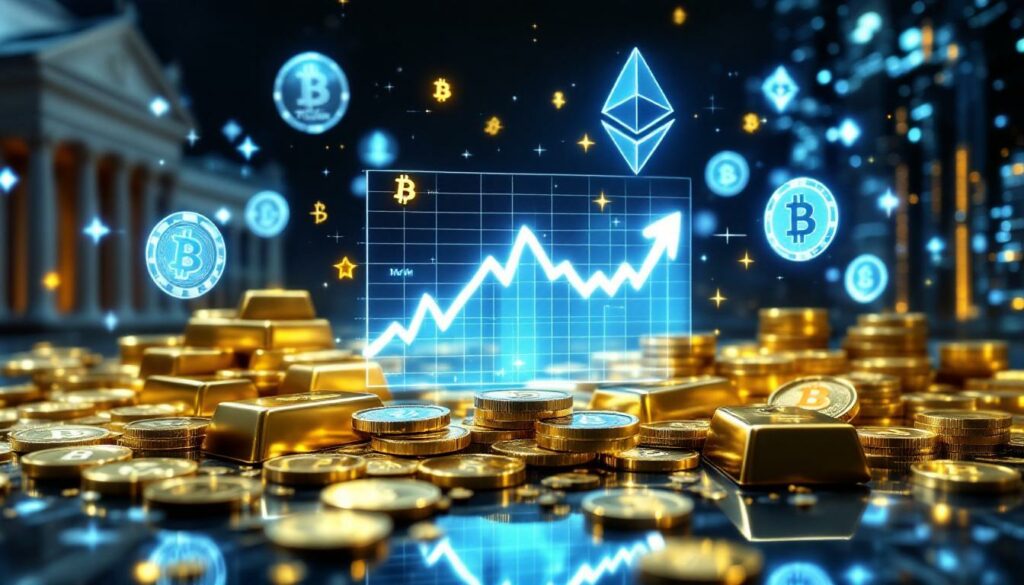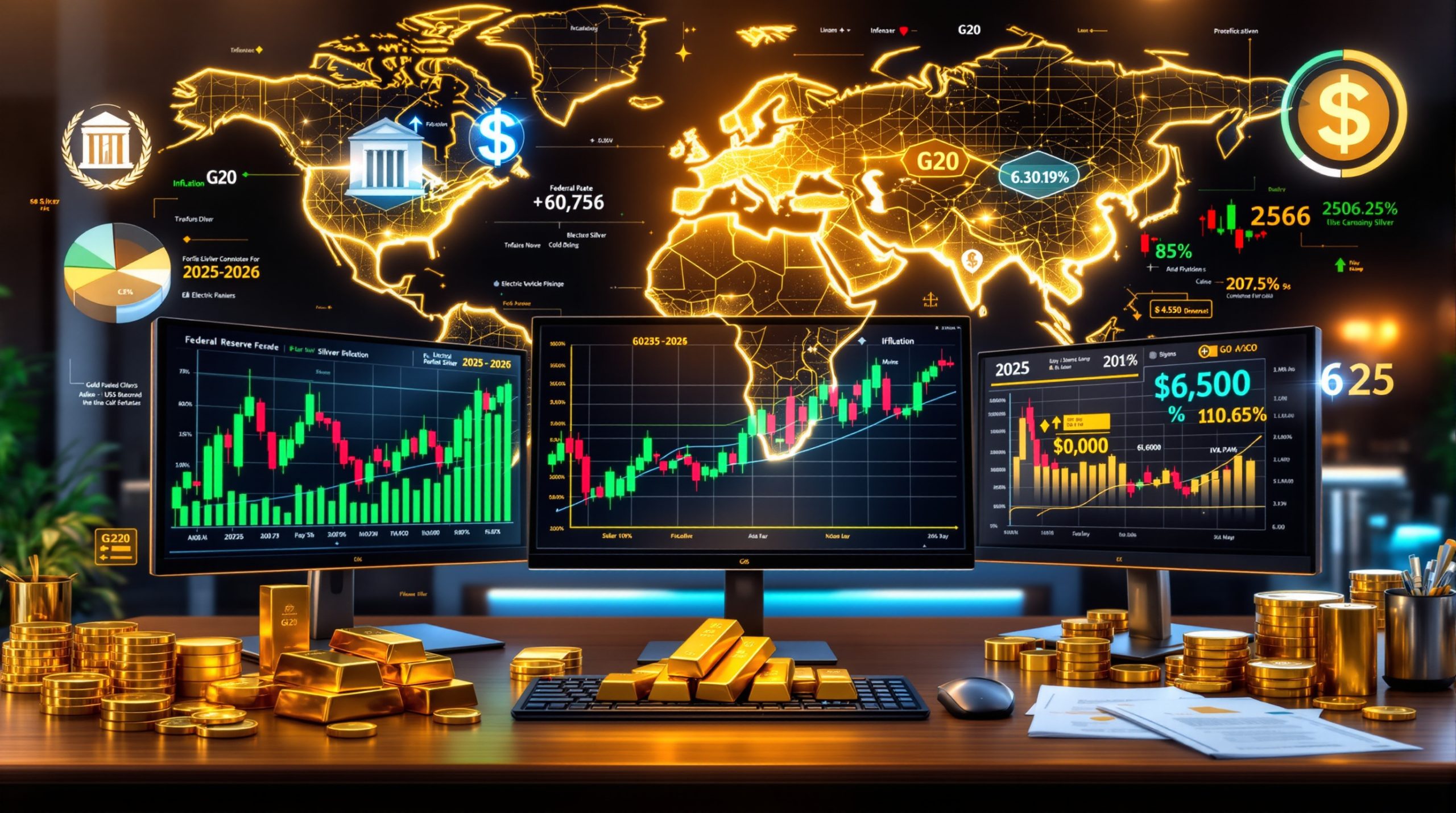How Do Cryptocurrencies Affect Precious Metals Markets?
The Competition for Alternative Investment Dollars
Cryptocurrencies and precious metals emerged approximately 12-13 years ago as a significant alternative investment class, creating new options for investors seeking diversification outside traditional markets. This development has influenced precious metals markets in several fundamental ways.
The introduction of cryptocurrencies has diverted substantial investment capital that might otherwise have flowed into gold and silver markets. As Andrew Slate, a precious metals expert, explains: "If these cryptos weren't around, that money would have gone into silver and gold and that would have been a huge uptick on physical demand."
Both asset classes appeal to investors seeking alternatives outside conventional stock and bond markets, often attracting similar investor profiles looking for assets that function independently of central bank policies.
Cryptocurrency volatility frequently triggers movements in precious metals as investors shift between alternative assets during market turbulence. When crypto markets experience significant corrections, capital often flows toward precious metals as investors seek more tangible safe havens.
Market sentiment oscillates between these assets during periods of economic uncertainty, with precious metals typically gaining favor during high-inflation environments while cryptocurrencies often benefit during periods of technological optimism.
Historical Price Correlation Analysis
The relationship between cryptocurrency and precious metals prices has evolved significantly since Bitcoin's inception:
- During early crypto adoption (2013-2017), precious metals showed minimal correlation with cryptocurrency price movements, as the crypto market was still nascent.
- The 2020-2022 period revealed more noticeable inverse correlations during major market events, including COVID-related liquidity crises.
- Recent data suggests cryptocurrency sell-offs occasionally coincide with precious metals rallies as investors seek tangible safe havens when digital assets face regulatory challenges.
- Market liquidity crises tend to impact both asset classes simultaneously despite their fundamental differences, as investors liquidate alternative assets during broad market panics.
Following announcements about upcoming Central Bank Digital Currencies (CBDCs), particularly the European Union's 2025 launch timeline, these correlation patterns have intensified, with regulatory uncertainty driving increased precious metals demand.
What Are the Key Differences Between Cryptocurrencies and Precious Metals?
Physical Ownership vs. Digital Representation
The fundamental distinction between these asset classes lies in their tangible nature:
Precious metals exist as physical assets you can hold, store, and transfer without technological dependencies. As Andrew Slate notes, "When you have physical metal in your hand, you actually own something tangible."
Cryptocurrencies exist as digital entries on distributed ledgers requiring technological infrastructure, exchanges, internet access, and specialized knowledge to maintain and transfer.
Physical metals remain accessible regardless of power outages, internet disruptions, or exchange failures, providing resilience during systemic crises when digital systems may be compromised.
Digital assets require functioning networks, exchanges, and access credentials to maintain ownership control, creating multiple potential failure points.
A stark example from the transcript highlights this difference: "A Canadian gentleman had $120 million in crypto on his laptop. He died, and nobody knows the password. That money is gone forever." With physical metals, this scenario is impossible – the assets remain accessible to heirs.
Counterparty Risk Considerations
Investors face significantly different risk profiles when comparing these alternative assets:
Precious metals held in physical form eliminate counterparty risk once in your possession. Even when dealers like Scotia Bank exit the market, the metal retains its value and can be liquidated through numerous other channels.
Cryptocurrencies typically involve multiple counterparties (exchanges, wallet providers, network validators). As Slate warns: "If you have $10 million in crypto on Coinbase and they suspend withdrawals, that's them suspending control of your so-called asset."
Exchange failures, hacks, and lost access credentials have resulted in billions of cryptocurrency losses, with limited or no recourse for affected investors.
Physical metals remain accessible to heirs even after an owner's death, unlike cryptocurrencies with lost credentials, which become permanently inaccessible.
Historical Track Record and Stability
The longevity and established market dynamics of each asset class differ dramatically:
Gold and silver have functioned as wealth preservation vehicles for thousands of years across civilizations, maintaining purchasing power despite currency debasements and economic collapses.
Cryptocurrencies have existed for approximately 15 years with significant volatility and numerous failed projects that have left investors with worthless tokens.
Precious metals maintain relatively stable purchasing power over decades despite price fluctuations, with gold outperforming the S&P 500 over the past 20 years according to Andrew Slate.
Digital assets have demonstrated extreme price volatility, with both spectacular gains and devastating losses, making them unsuitable for conservative wealth preservation.
Why Consider Precious Metals in Your Investment Portfolio?
Tangible Asset Advantages
Physical precious metals offer unique benefits that digital assets cannot replicate:
No technological dependencies for ownership verification or transfer – metal ownership is self-verifying and requires no third-party confirmation.
Cannot be "deleted" or rendered inaccessible through technological failures, hacks, or forgotten credentials. As Slate explains, physical metals provide "insurance against systemic collapse where no tech failure can delete them."
Maintain intrinsic value independent of financial system functionality, allowing them to serve as a medium of exchange even during banking crises or electronic payment outages.
Provide portfolio insurance against extreme market scenarios and systemic failures where traditional and digital assets may become inaccessible or severely devalued.
Industrial Demand Creates Price Support
Unlike purely speculative assets, precious metals benefit from significant industrial applications:
| Metal | Key Industrial Applications | Annual Industrial Demand |
|---|---|---|
| Silver | Electronics, solar panels, medical devices | ~60% of annual production |
| Gold | Electronics, aerospace, medical equipment | ~10-15% of annual production |
| Platinum | Catalytic converters, chemical processing | ~60% of annual production |
Silver market dynamics continue to increase with green energy adoption, as each solar panel and electric vehicle requires substantial silver content. This industrial foundation provides a demand floor that purely digital assets lack.
Gold's applications in electronics and aerospace provide additional demand beyond its monetary role, creating more price stability than speculative-only assets.
Platinum's critical role in catalytic converters and industrial processes ensures ongoing demand regardless of investment trends, though this also makes it more susceptible to economic downturns.
Established Liquidity Networks
The global infrastructure for precious metals trading provides reliable liquidity advantages:
Worldwide dealer networks ensure ability to buy and sell regardless of local economic conditions. Even when major dealers exit the market, as Scotia Bank did with their trading desk, physical metals can still be liquidated through other channels.
Multiple exit strategies exist even if primary dealers cease operations, providing resilience during financial disruptions. As Slate notes, "If Scotia Bank was refusing to buy back metal, there's always an additional firm to liquidate with."
Standardized forms (coins, bars) with recognized specifications facilitate transactions across borders and between private parties without requiring specialized technological knowledge.
Physical metals can be liquidated through numerous channels during financial disruptions when digital systems may be compromised or inaccessible.
How Do Different Precious Metals Compare as Investments?
Gold: The Monetary Standard
Gold maintains its position as the primary precious metal investment vehicle:
Recognized globally as a monetary metal with minimal counterparty risk, gold has been the standard for wealth preservation for millennia.
Highest market liquidity among precious metals ensures ease of buying and selling in virtually any economic environment and in any country.
Central bank holdings provide institutional demand floor – governments continue to accumulate gold reserves, with central banks becoming net buyers since 2010.
Compact storage relative to value (high value-to-volume ratio) makes gold ideal for substantial wealth preservation in limited space – $1 million in gold can be stored in a small safe, while the same value in silver requires significantly more space.
Silver: Industrial and Monetary Hybrid
Silver offers a unique combination of industrial utility and monetary history:
Dual demand drivers from both industrial applications and investment interest create what Andrew Slate calls a "super advantage" compared to other metals.
Higher potential percentage gains during bull markets due to smaller market size – the silver market is approximately 1/10 the size of the gold market, allowing for more dramatic price movements.
Greater affordability for smaller investors seeking physical ownership makes silver accessible to a broader range of investors for initial precious metals positions.
Industrial consumption creates continuous supply pressure, with growing demand from electronics, solar energy, and medical applications consuming approximately 60% of annual production.
Slate emphasizes that silver's smaller market makes it more responsive to investment flows: "When money starts flowing back into precious metals, silver will move more dramatically percentage-wise than gold."
Platinum: Specialized Industrial Metal
Platinum presents a more specialized investment case:
Primarily driven by industrial demand rather than monetary applications, making it more susceptible to economic slowdowns. As Slate notes, "Platinum at the end of the day is not a monetary metal. It's an industrial metal."
Significantly smaller market with potential liquidity challenges during crises – platinum's niche status means fewer dealers specialize in it compared to gold and silver.
Higher price volatility due to concentrated production sources (primarily South Africa and Russia), creating supply vulnerabilities during geopolitical tensions.
Limited recognition as a monetary metal among general population means platinum might be more difficult to use in barter scenarios during economic crises.
What Risks Should Investors Consider with Each Asset Class?
Cryptocurrency-Specific Risks
Digital assets present several unique challenges for investors:
Exchange security vulnerabilities and potential platform failures create significant counterparty risk. As Slate cautions, "When an exchange suspends withdrawals, they're suspending control of your so-called asset."
Regulatory uncertainty and potential government restrictions loom large, particularly with the advent of Central Bank Digital Currencies (CBDCs). As governments introduce their own digital currencies, private cryptocurrencies may face significant regulatory challenges or outright bans.
Technological obsolescence as newer protocols emerge threatens the value of existing cryptocurrencies, creating a risk not present with elemental precious metals.
Access dependency on passwords, keys, and functioning infrastructure means permanent loss is possible if credentials are lost. The Canadian example of $120 million in inaccessible crypto due to a lost password highlights this unique risk.
Precious Metals Risks
Physical metals also present certain challenges investors should understand:
Storage and security requirements for physical possession necessitate proper planning. Secure storage options include home safes, private vaults, and allocated storage with trusted institutions.
Potential premium volatility during market disruptions can temporarily affect buying and selling prices, particularly for smaller denomination products like coins and small bars.
Transportation logistics for larger holdings can be challenging, especially during crises or when moving across international borders.
Verification requirements for authenticity during private transactions require basic knowledge or testing equipment to ensure genuine products.
Market Manipulation Concerns
Both asset classes have faced scrutiny regarding price discovery mechanisms:
Precious metals markets have experienced documented manipulation through futures markets, with several major banks paying significant fines for precious metals price manipulation over the past decade.
Cryptocurrency markets have shown vulnerability to whale movements and exchange manipulation, with limited regulatory oversight allowing for price manipulation tactics that would be illegal in traditional markets.
Regulatory oversight differs significantly between established metals markets and emerging crypto markets, with precious metals markets having more mature regulatory frameworks despite their imperfections.
Price discovery mechanisms continue evolving in both sectors, with physical precious metals often trading at significant premiums to paper spot prices during high-demand periods.
How Might Central Bank Digital Currencies Impact These Assets?
CBDC Implementation Timeline
The global movement toward central bank digital currencies appears to be accelerating:
European Union has announced CBDC development targeting October 2025, according to Andrew Slate citing a March 12, 2025 announcement.
United States, United Kingdom, Australia and other major economies are advancing digital ID frameworks as precursors to CBDC implementation. Australia's Digital ID Act came into force on August 16, 2024.
Financial infrastructure providers like Mastercard are developing digital ID certification systems, with Mastercard already certified for digital ID services in the UK.
Private stablecoin providers are pursuing banking licenses to integrate with emerging systems, positioning themselves within the new CBDC ecosystem.
The EU has also mandated digital ID and wallet implementation for citizens by 2026, with a ban on privacy coins scheduled for 2027.
Potential Impact on Alternative Assets
The emergence of CBDCs may significantly influence both cryptocurrencies and gold prices analysis 2025:
Government-issued digital currencies could restrict or eliminate private cryptocurrencies. As Slate predicts, "When CBDCs start to get launched, they won't allow competition – the cryptos will be shut down instantly."
Regulatory frameworks may impose restrictions on private digital asset transactions, potentially making cryptocurrency holdings inaccessible or illegal in certain jurisdictions.
Precious metals could see increased demand as privacy-focused alternatives to fully-traceable CBDCs. Investors concerned about financial surveillance may turn to physical metals for a portion of their wealth.
Transition periods may create significant market volatility in both asset classes as investors reposition portfolios in response to new regulatory frameworks.
Privacy Implications and Asset Flows
The implementation of digital IDs and CBDCs raises important considerations:
Potential restrictions on private messaging and financial privacy may drive demand for off-system alternatives. Slate notes that the EU is already planning to ban private messaging platforms.
Physical assets that can be transacted without digital surveillance may gain premium valuations in a CBDC environment where all digital transactions are potentially monitored.
Transition timeline variations across jurisdictions could create regulatory arbitrage opportunities as different countries implement CBDCs at different rates.
Market disruptions during implementation phases may trigger significant asset reallocations, potentially benefiting precious metals as investors seek privacy-preserving alternatives.
How Should Investors Approach These Alternative Assets?
Portfolio Allocation Strategies
Prudent investors might consider balanced approaches to alternative assets:
Limit cryptocurrency exposure to capital you can afford to lose completely. As Slate advises, "People should only go in with whatever they're prepared to write off."
Establish physical precious metals positions before exploring digital alternatives to ensure foundational wealth preservation outside the financial system.
Consider precious metals allocation as insurance rather than speculative investment – typically 5-15% of a portfolio depending on your risk tolerance and economic outlook.
Diversify within each asset class (different metals, different cryptocurrencies) to reduce specific risks associated with individual assets.
Take any profits from cryptocurrency speculation and convert them to physical metals to "lock in gains," as Slate recommends.
Security and Storage Considerations
Protecting alternative assets requires different approaches:
Physical metals require secure storage solutions (home safes, private vaults, allocated storage) with appropriate insurance coverage.
Cryptocurrencies require robust security practices (hardware wallets, backup procedures, recovery phrases stored in multiple secure locations).
Consider geographical diversification for physical assets during uncertain times, particularly if CBDC implementation may lead to restrictive regulations.
Establish inheritance protocols for both physical and digital assets to ensure heirs can access assets – particularly critical for cryptocurrencies where lost credentials mean permanent loss.
Exit Strategy Planning
Successful alternative asset investing requires predetermined exit approaches:
Take profits from volatile assets during significant upswings rather than trying to time the absolute peak. This is particularly important with cryptocurrencies.
Consider converting speculative gains into more stable forms, like physical precious metals, to preserve wealth generated from higher-risk investments.
Establish liquidity channels before market disruptions occur by maintaining relationships with multiple dealers and understanding various exit options.
Understand tax implications of different exit strategies, as precious metals and cryptocurrencies may have different tax treatment depending on your jurisdiction.
FAQs About Cryptocurrencies and Precious Metals
Are cryptocurrencies a replacement for precious metals?
No, cryptocurrencies and precious metals serve different functions in a portfolio. While both exist outside traditional financial markets, they have fundamentally different risk profiles, historical track records, and dependency requirements. Cryptocurrencies offer potential for speculative gains but with significantly higher risk, while precious metals provide time-tested wealth preservation with physical ownership benefits.
As Andrew Slate emphasizes, cryptocurrencies require technological infrastructure and involve counterparty risk, while physical metals can be held directly with no dependencies. This fundamental difference makes them complementary rather than interchangeable assets.
Which precious metal offers the best investment potential?
Silver currently offers unique advantages due to its dual role as both industrial metal and monetary asset. Its relatively small market size compared to gold means price movements can be more dramatic during bull markets. Additionally, increasing industrial demand from green energy technologies creates continuous supply pressure that may support prices long-term.
For investors seeking maximum liquidity and recognition, gold remains the standard. For those willing to accept more volatility in exchange for potentially higher percentage gains, silver presents a compelling case, particularly with its growing industrial applications.
How much of my portfolio should be allocated to alternative assets?
Financial advisors typically recommend 5-15% of a portfolio in alternative assets like precious metals, depending on your risk tolerance and economic outlook. Cryptocurrency allocations should generally be limited to funds you can afford to lose entirely, given their speculative nature and significant volatility.
As Andrew Slate advises, cryptocurrency investments should be limited to "whatever you're prepared to write off" in a worst-case scenario. Precious metals, by contrast, can serve as portfolio insurance and wealth preservation, justifying a more substantial allocation.
What's the best way to take profits from cryptocurrency investments?
Converting cryptocurrency gains into physical precious metals represents a prudent strategy for locking in profits from volatile digital assets. This approach transforms speculative digital gains into tangible assets with established value preservation characteristics and eliminates ongoing technological dependencies.
As Slate recommends, "Take any profit gained out of the system immediately and put it into something to lock their gain, which would be physical metal." This strategy preserves wealth while reducing exposure to cryptocurrency volatility and counterparty risks.
How will government digital currencies affect private cryptocurrencies?
Government-issued digital currencies will likely create significant regulatory challenges for private cryptocurrencies. As central bank digital currencies become established, governments may restrict or eliminate competing private digital currencies through regulatory frameworks
Ready to Protect Your Wealth from Market Volatility?
Discover how real-time alerts on significant ASX mineral discoveries could provide the portfolio insurance you need in uncertain times by visiting Discovery Alert's dedicated discoveries page, where the proprietary Discovery IQ model transforms complex mineral data into actionable investment opportunities.




